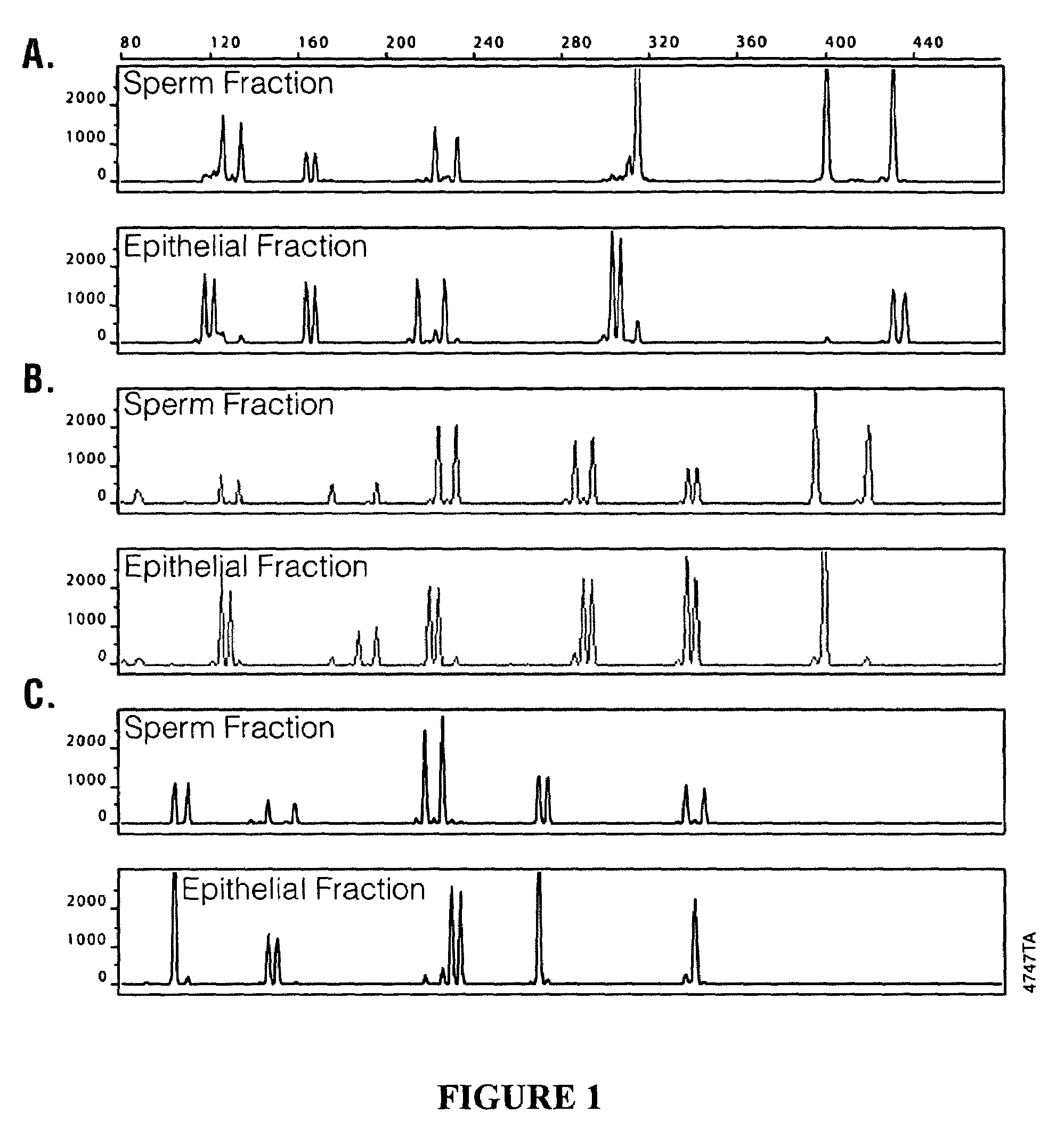Methods and kits for isolating sperm cells
a technology of sperm cells and kits, which is applied in the field of methods and kits for isolating sperm cells, can solve the problems of time-consuming and laborious techniques currently used to isolate sperm cells from other cells in forensic samples, and the dna purified from forensic samples is susceptible to overwhelming contamination with epithelial cell dna,
- Summary
- Abstract
- Description
- Claims
- Application Information
AI Technical Summary
Benefits of technology
Problems solved by technology
Method used
Image
Examples
example 1
Isolation of Sperm Cells from Samples Containing Epithelial Cells
[0030]Samples used in evaluating sperm cell isolation included a fresh buccal swab containing added semen, fresh or four year old vaginal samples containing added semen, and a four year old 11-hour post coital vaginal sample. The solid support (e.g., a swab) containing the samples were placed in a microcentrifuge tube. A 0.5 ml aliquot of a digestion solution containing 50 mM NaCl, 10 mM Tris, pH 8.0, 10 mM EDTA, 0.2% SDS, FD&C Yellow dye, and 270 μg / ml Proteinase K was added to each sample. The tubes containing the samples were vortexed for 30 seconds and incubated at 56° C. for 1 hour. Diethyl glutarate and dimethyl glutarate were combined at ratios of 100:0, 50:50, 40:60, 30:70, 20:80, and 0:100 DEG:DMG to form mixed non-aqueous liquids. The ratio of 50:50 formed a liquid with a density of about 1.055 g / cm3. A 100 μl aliquot of the non-aqueous liquid including ratios of 100:0, 50:50, 40:60, 30:70, 20:80, or 0:100 DE...
example 2
Isolation of DNA from Sperm Cells or Lysed Epithelial Cells Using Chaotropic Salt and Reducing Conditions
[0032]The DNA from the sperm cell pellet of Example 1 was isolated according to DNA isolation methods described in Promega Technical Bulletin TB296 using components provided in the DNA IQ™ system (Promega Corp., Madison, Wis. Cat. No. DC6701). A 200 μl aliquot of DNA IQ™ lysis buffer containing 4.5 M guanidine thiocyanate (GTC) and 10 mM dithiothreitol (DTT) was added to the microfuge tube containing the non-aqueous liquid and sperm cell pellet, and vortexed briefly to disrupt the sperm cell pellet and to form a homogenous mixture of the non-aqueous phase and the lysis buffer.
[0033]A 7 μl aliquot of DNA IQ™ Resin was added to the solution and mixed by vortexing at high speed for 3 seconds and incubated at room temperature for 5 minutes. The mixture was vortexed for 2 seconds at high speed, the tube was placed in a magnetic stand, and after the paramagnetic resin was attracted to ...
example 3
Isolation of DNA from Sperm Cells Using a Detergent and Phenol:Chloroform Extraction
[0035]The DNA from the sperm cell pellet of Example 1 was isolated by first removing the non-aqueous liquid to leave a firm sperm cell pellet. A 300 μl solution containing 10 mM Tris, pH 8.0, 1 mM EDTA, 10 mM DTT, and 1% SDS was added to the sperm cell pellet, and the tube was vortexed to lyse the sperm cells and dissolve the DNA. An equal volume of phenol:chloroform (1:1, v / v) was added and vortexed to denature the protein. The aqueous DNA-containing solution was removed, concentrated in a Microcon® apparatus, washed with 200 μl of a buffer containing 10 mM Tris, pH 8.0, 0.1 mM EDTA, and concentrated again in the Microcon® apparatus to about 40 μl. The purified DNA was transferred to a clean container.
PUM
| Property | Measurement | Unit |
|---|---|---|
| density | aaaaa | aaaaa |
| density | aaaaa | aaaaa |
| density | aaaaa | aaaaa |
Abstract
Description
Claims
Application Information
 Login to View More
Login to View More - R&D
- Intellectual Property
- Life Sciences
- Materials
- Tech Scout
- Unparalleled Data Quality
- Higher Quality Content
- 60% Fewer Hallucinations
Browse by: Latest US Patents, China's latest patents, Technical Efficacy Thesaurus, Application Domain, Technology Topic, Popular Technical Reports.
© 2025 PatSnap. All rights reserved.Legal|Privacy policy|Modern Slavery Act Transparency Statement|Sitemap|About US| Contact US: help@patsnap.com

